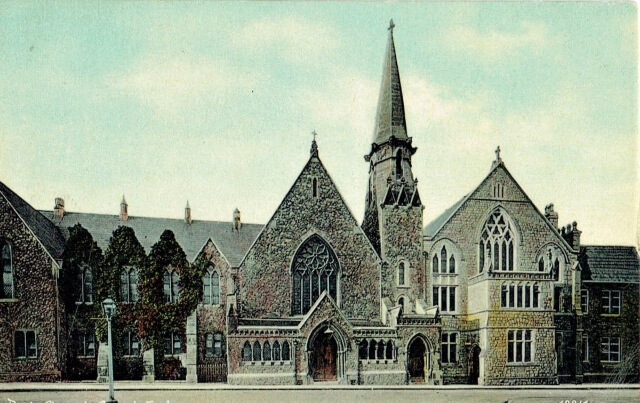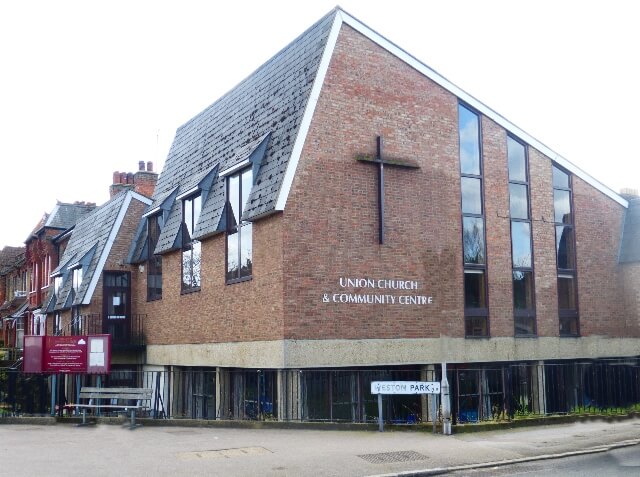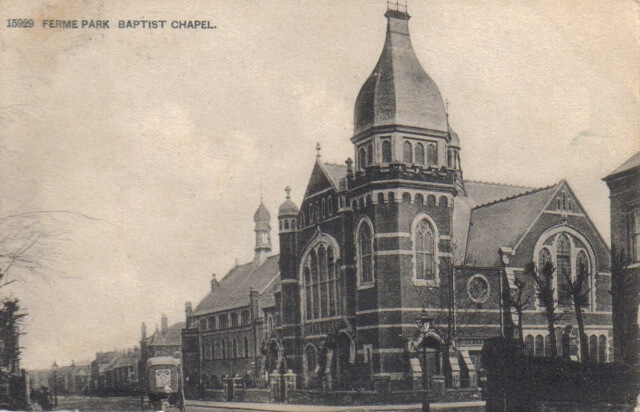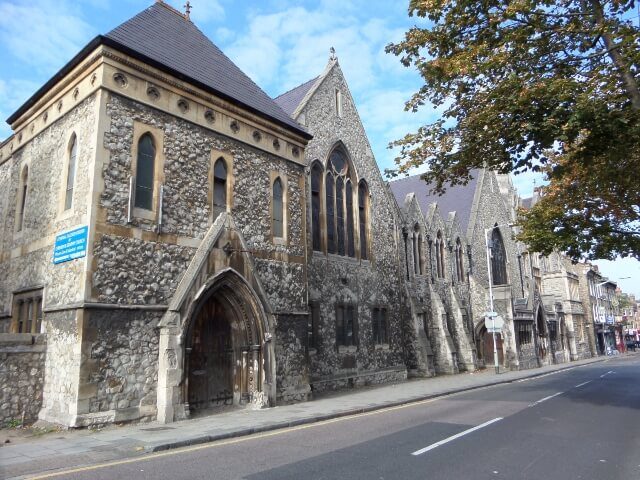Another article in our series about church buildings which have changed their function.
This imposing mid-1850s building is best viewed from Haringey Park N8 or whilst walking on Crouch Hill. Park Chapel has had a chequered 167 year existence. It has changed from an important Congregational church and centre of social activity for the community, to a wrecked church interior with the hall and other spaces used for commercial purposes, particularly children’s TV production and as a recording studio, back once more to a church interior restored for worship.
An important place of worship
Nonconformist churches flourished in Crouch End at the late 19th century. Congregationalists in the area met first in Broadway Hall, Crouch End Broadway, moving in 1855 to their newly built church on Crouch Hill. This congregation increased rapidly under the first minister Rev John Corbin and then under Rev Dr Alfred Rowland, who played a prominent role in the national Congregational Union. Park Chapel was enlarged for the fourth time in 1885 and could seat some 1,500 people.

The multi-purpose building
Between 1862 and 1875 the church’s spacious accommodation included a nonconformist elementary school called the Hornsey British School, teaching young children the ‘elements’ of education – reading, writing, number and religious instruction. This moved to be part of Crouch End Board School on Park Road in 1877. Park Chapel was one of the churches providing a public library before the advent of public libraries by Hornsey Urban District Council at the end of the 1890s.
Corbin Hall opened as a social centre in 1893. The Social Union met there from 1895 to 1929. This organisation had an ambitious brief – to invite speakers for weekly lectures on literary, artistic and political subjects – attractive to Crouch End’s middle class residents. The Union had an initial membership of 400. In 1897 the Daily Sketch commented on the number of eminent journalists among the congregation.
Park Chapel’s ministers, church officers and congregation worked closely with those of other denominations, particularly Ferme Park Baptist Church over radical social and political issues. Ministers and members of both churches were prominent, locally and nationally, in passive resistance to the 1902 Balfour Education Act which brought voluntary church schools into the sphere of state education by funding them through the local Council rates. In the Inter-War years branches of the League of Nations Union at Ferme Park and Park Chapel helped organise the Hornsey vote in the Peace Ballot of 1935, organised by the League of Nations.
Park Chapel faces a post-war crisis
The issues causing the crisis are explained in the first article in this series. Population shrinkage as birth control methods became common and two world wars led to religious scepticism and a decline in church attendance. In the late 1960s another factor impacted on Park Chapel. In 1972 the Presbyterian Church of England and the Congregational Church in England and Wales joined as The United Reformed Church. As a Congregational church, the congregation of Park Chapel could make a choice and decided not to stay in the United Reformed Church.
What to do next? Union with Ferme Park Baptist Church
In 1973 Park Chapel and Ferme Park Baptist Church merged as the Union Church, though still in two buildings. Once a powerful church like Park Chapel, this Baptist congregation also worshipped in a building which was now much too large. The new union led to momentous decisions by both congregations. Neither church was practical for worship in the 1970s.
The plan was to sell Park Chapel and demolish Ferme Park Church and use the site for a modern church with the rest sold for housing. Inevitably the Park Chapel congregation were concerned about selling their church. It had been their spiritual home for many years, the interior woodwork was beautiful and the Willis organ magnificent. Joan Schwitzer, HHS Chairman unsuccessfully attempted to get the building listed with Department of the Environment. Park Chapel was sold in 1978 for £95,000 and the money raised from both church sites put towards the costs of the new Union Church building which opened in 1980.


A new era begins under various ownerships
Bob Bura and John Hardwick of Bura and Hardwick Animations, who specialised in making children’s TV programmes such as Camberwick Green, Pinky & Perky, Captain Pugwash and Windy Miller, bought Park Chapel. All did not go smoothly. Bura and Hardwick insisted that the Council had assured them when they bought the building that their rates would be very low as they promised to conserve the church. They did not use the church space only the rooms and adjoining hall. When the Council expected them to pay full rates Bura and Hardwick rendered the church unusable to qualify for half rates. Part of the building has been used commercially ever since, being occupied by Church Studios, one of Europe’s leading commercial recording studios.
Church Studios up for sale
In 2012 the artistic use of Church Studios came under threat. A petition entitled, Save Our Studios, told the story,
‘Church Studies has served as a hub for musicians and artists from near and far for decades. Once owned by Eurythmics founder, Dave Stewart, host to legendary recording artists such as Bob Dylan and Radiohead, and currently owned by multi-platinum selling artist Dave Gray, recent plans to sell off the Studios and redevelop the building into flats and offices will impact the cultural vitality of the area and could uproot many other local artists and creatives actively working within the building. The beautiful and spacious interior of the Church, preserved since 1855, would also be permanently transformed, should planning be approved.’
The petition to Haringey worked and the proposed plans never went ahead.
Worship returns to Park Chapel; now Mount Zion Cathedral

Amazingly, the unusable church interior has been restored as a place of worship by a congregation of the Eternal Order of Cherubim and Seraphim who bought it from Bura and Hardwick. Founded in 1925, born out of Anglican Church community among the Yoruba people of Western Nigeria, the congregation worship in Yoruba and English. A grant from the Heritage Lottery Fund and congregation’s hard work saw the interior fully restored and named Mount Zion Cathedral.* What goes around, comes around.
*See HHS Member Andrew Whitehead’s book, Curious Crouch End, Five Leaves Publications (2021) for a full account. On sale at HHS, The Old Schoolhouse, 136 Tottenham Lane, London N8 7EL.
Image credits
Park Chapel today and Union Church today – Lesley Ramm.
Park Chapel, 1900 and Ferme Park Baptist Chapel, 1914 – HHS